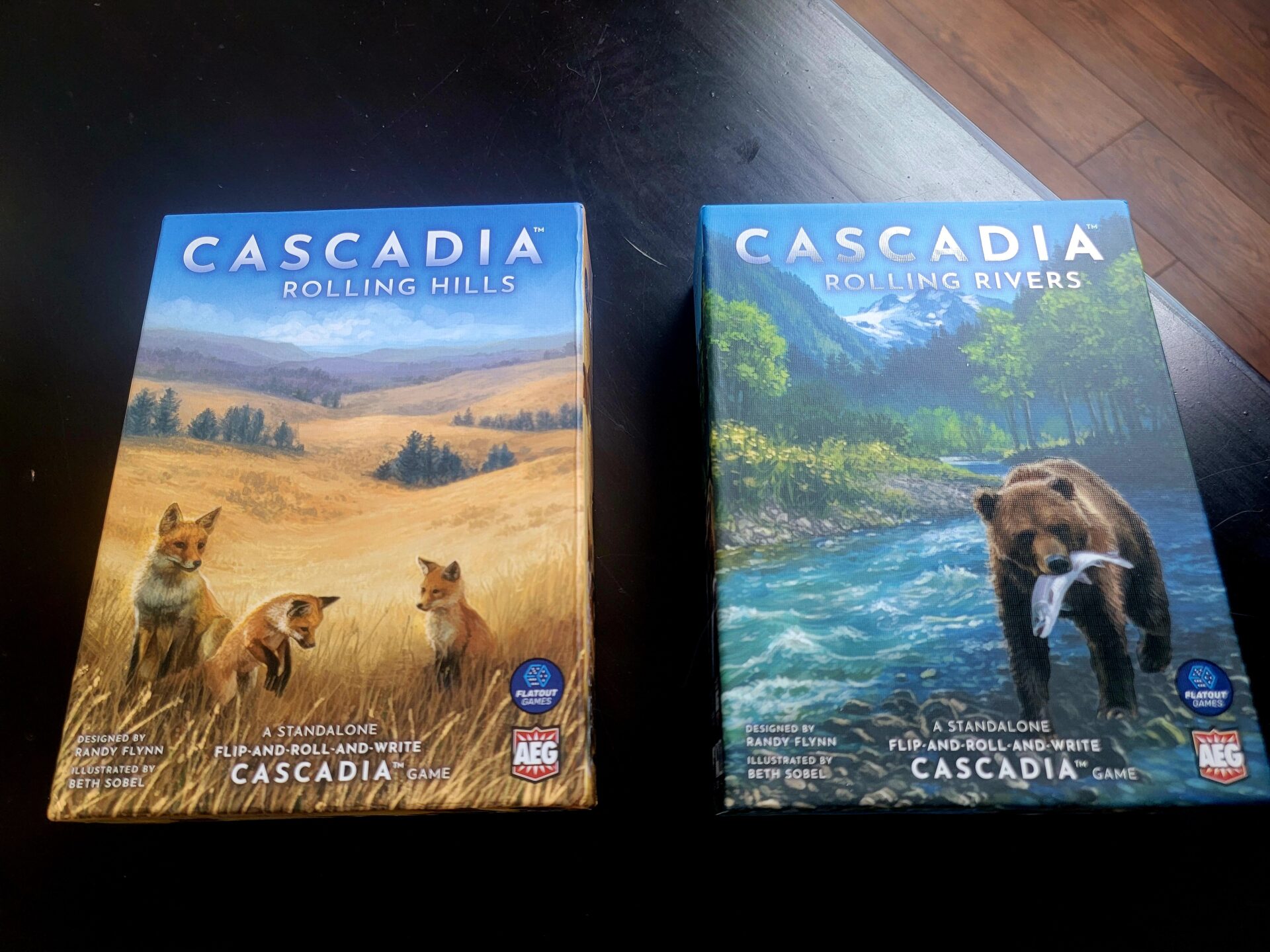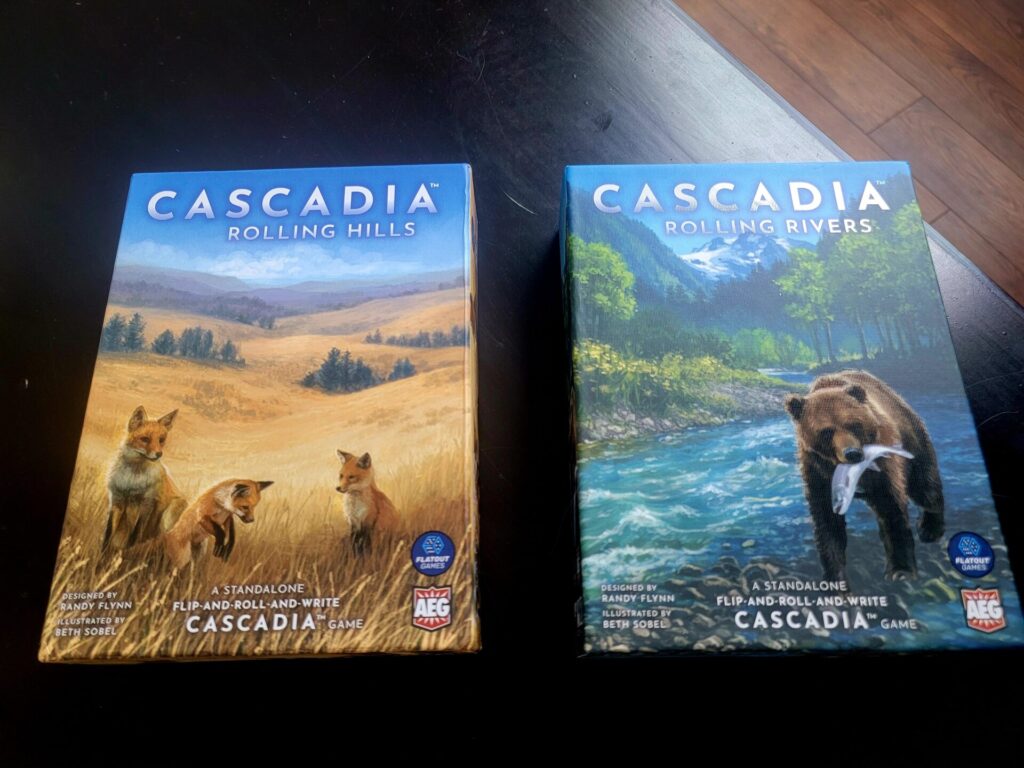
Name: Cascadia Rolling Rivers
Year of Release: 2024
Player Count: 1 – 4
Playing Time: 15 – 30 Minutes
Designer: Randy Flynn
Publisher: Flatout Games
Primary Mechanisms: Dice Rolling, Hexagon Grid, Market, Set Collection
Weight (According to BGG.com): 1.83
Overview
I don’t exactly know when “roll-and-write” games took off in the modern board gaming era but technically Yahtzee is a R&W game and it was first published in the 1950’s, so this style of game has been popular for nearly three quarters of a century. I think the more interesting question is when did so many R&W spin-offs start filling the marketplace? My first encounter with one of these would have been “Patchwork: Doodle” in 2019 but one can scroll through BGG and see numerous examples: “Fleet: the Dice Game”, “Troyes Dice”, “Imperial Settlers: Roll & Write”, “Dinosaur Island: Rawr ‘n Write” and “Lost Cities: Roll & Write.”
That brings us to the subject of this review: Cascadia Rolling. Cascadia hit the scene in 2021, making a huge splash. At the time of this writing (Q3 of 2024), it sits at #46 on the overall BGG ranking, with a #1 spot on the BGG Abstract list. Even three years later, it is winning over converts. So, does the “roll-and-write” treatment do the original justice or is it just a way to capitalize on the original game’s popularity? Read on to find out!
Note: while Cascadia Rolling Rivers and Cascadia Rolling Hills are 2 different products, 95% of the two games are identical. I will be referring to the games as Cascadia Rolling moving forward but will call out the slight differences in the two products where applicable.
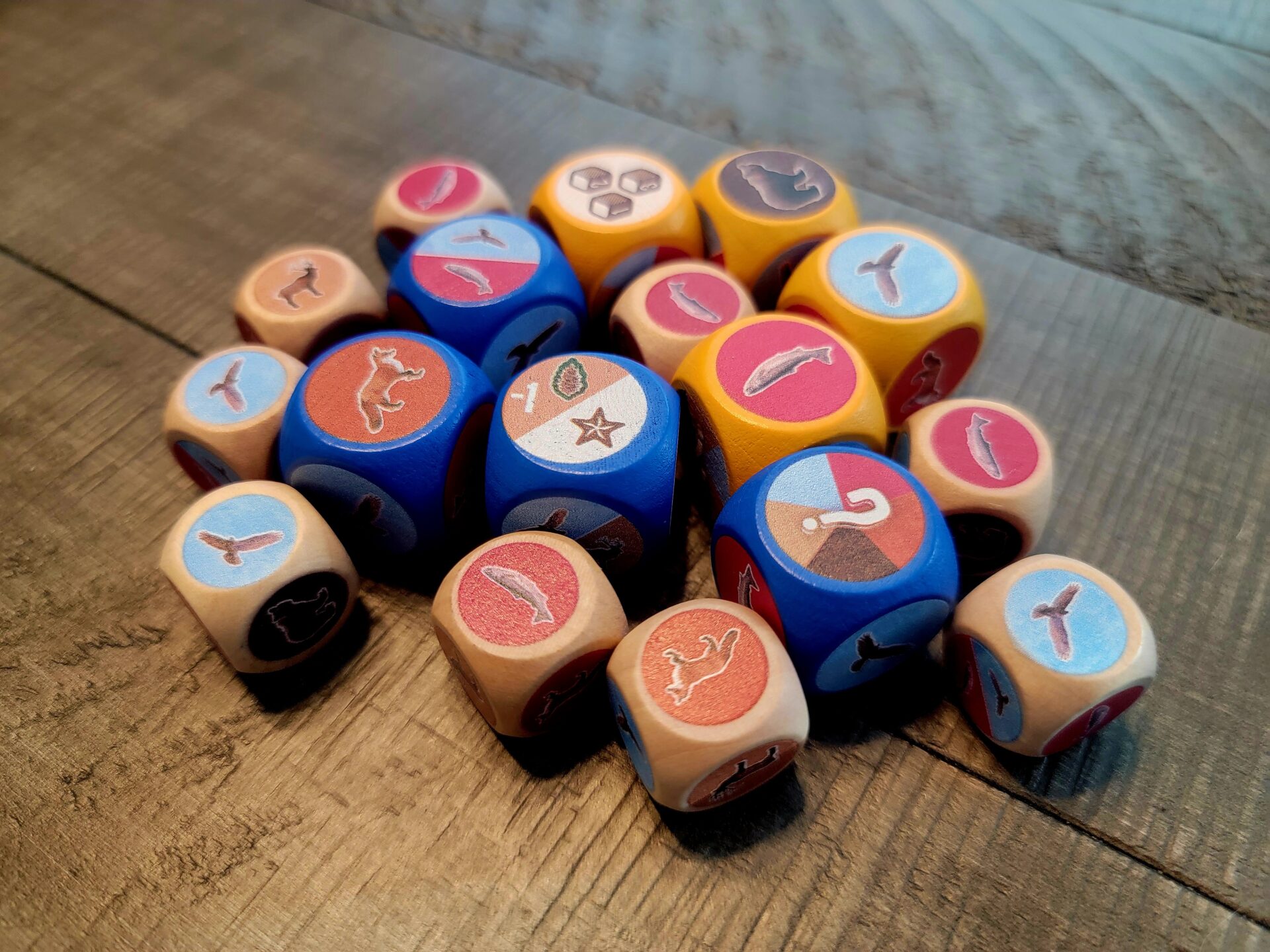
Components
Even if you’ve never played a R&W game before, you’ve probably already guessed that at least two of the components will be some amount of dice and at least one pad to write on. If so, you would be correct, and Cascadia Rolling is no different. In this game, players will receive two pads. The first contains Tally Sheets to keep up with the Animal Icons and Nature Tokens you’ve collected throughout the game. The second pad is a collection of four different Environment Sheets, labeled Map A through Map D. Map A acts as the least complex, with the complexity increasing as you move towards Map D. Be aware that both iterations of Cascadia Rolling includes three maps (A, B, and C) that are basically identical. Map D does have a few differences, especially when it comes to scoring but the gist of the gameplay is similar. I think the primary justification for buying both is, you can increase the player count from a maximum of four players to a maximum of eight, but it’s still a bit disappointing to have the same maps across both products.
When it comes to the dice, Cascadia Rolling contains four large dice and eight smaller dice. These smaller dice (Personal Dice) have the Animal Icons printed on the six sides while the larger dice (Central Dice) contain a multitude of bonus or special action icons. These dice are the key difference between the two iterations of Cascadia Rolling. Rolling Rivers’ Central Dice are blue and primarily help players to multiply icons rolled on their Personal Dice or help players to gain an additional Animal Icon. Conversely, Rolling Hills’ Central Dice are yellow and give players the power to re-roll Personal Dice rolls.
The last components in Cascadia Rolling are two decks of cards. The larger of the two are the Habitat Cards and will be the main driving force behind gaining points in the game. Each card lists a price in Animal Icons, a Habitat type with an associated point value, and a possible bonus of Nature Tokens. The background of each card has a beautiful rendition of the stated habitat and really makes the market of cards stand out on the table.
The smaller deck of cards (Completion Cards) contains either Discounts or Bonuses that will be awarded to players when buying Habitat Cards. While there isn’t much to these cards, I appreciate how the iconography easily alerts players to the action of the card without needing Rule Book intervention.
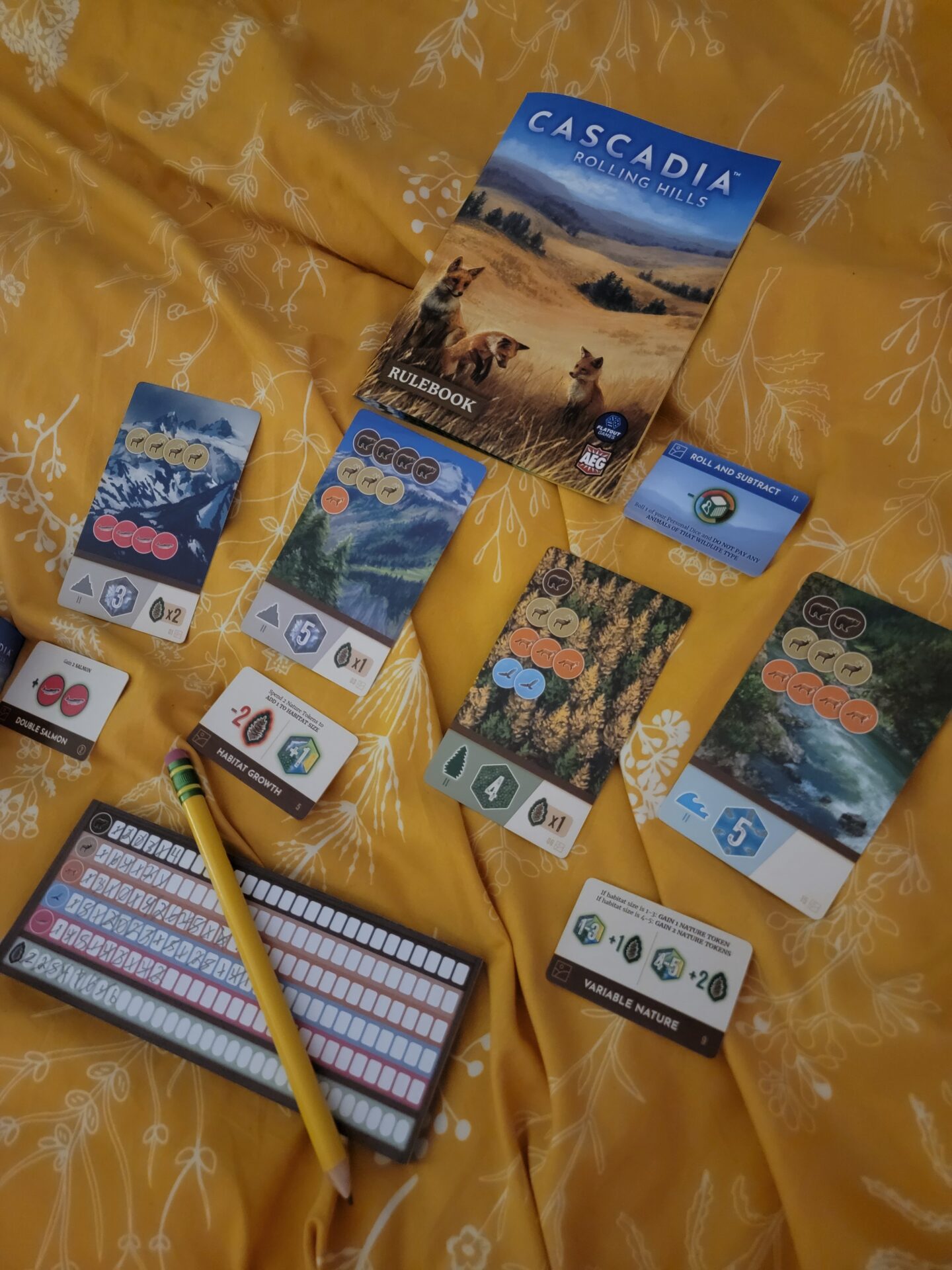
Setup & Gameplay
Setup in Cascadia Rolling is as easy as it might seem based on the lack of components. First, someone needs to separate the Habitat Cards into a pile for the ones marked with I and another with the cards marked II. In each stack, one of each of the 5 Habitats should be randomly removed and put back in the box. The two stacks are then shuffled separately and then the I cards are placed on top of the II cards to make the Draw Deck.
The Completion Card deck should be shuffled and four cards randomly drawn with the rest being placed back in the box. These four cards are then placed on the table side by side, creating four columns. The top Habitat Card is drawn and placed face-up under the left most Bonus card. Note: technically the Bonus Cards go below the Habitat Cards and any Discount Cards go below the Habitat Cards but I’m trying to keep this simple. The four Special Dice are placed in the middle of the table in all players’ view and two Personal Dice are given to player. Lastly, players need to agree which map they are going to play and this map, along with Tally Sheets and writing utensils are given to each player. The game is then ready to be started.
At the beginning of a round, one player rolls the four community Central Dice and then all players roll their Personal Dice. Based on the outcome of the rolls, players will decide which Animal Icon to collect. Typically, this means the player will count up the amount of a single Animal Icon rolled across both their Personal Dice and the Central Dice and add this amount to their Tally Sheet. For example, if I rolled a Fox and a Bear, my neighbor rolled a Fox and an Elk and the Special Dice showed two Elk, I could either collect a single Fox or a single Bear (from my personal rolls) or two Elk (from the community roll.) My opponent could either choose to collect a single Fox (from her personal roll) or three Elk (from the combination of personal and community rolls.)
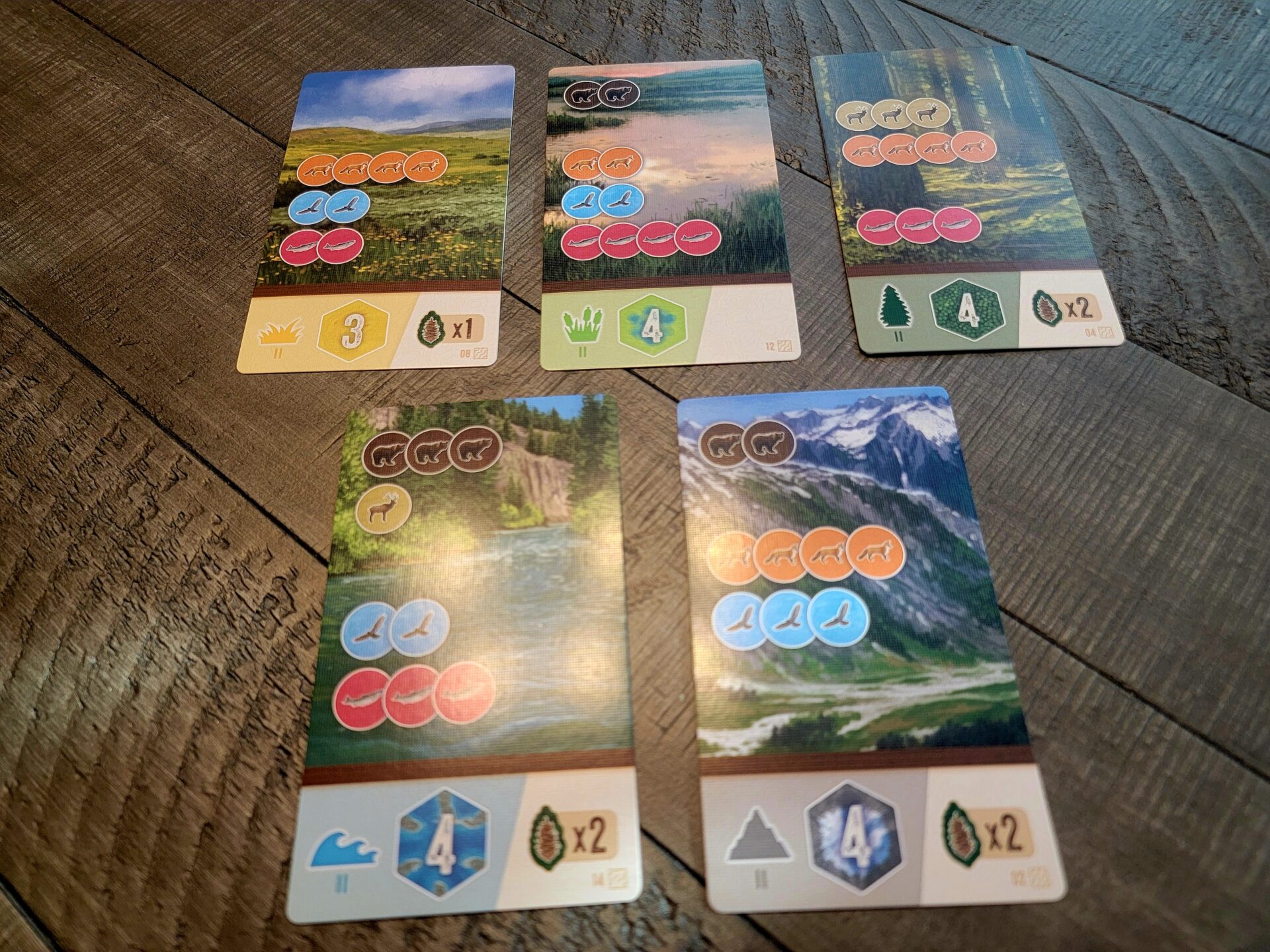
Once all players have marked their Tally Sheets, they are given a chance to “purchase” a Habitat Card. I put this in quotes because players won’t actually remove the card from the market. Instead, players will mark off the required amount of each animal printed on the Habitat Card from their Tally Sheet. Then they will mark their Environment Sheet using the Point Value and Habitat Type found on the purchased card. Each of the maps handle this differently but we will look at each in a little more detail later on in the review. If there was a Discount Completion Card above the purchased Habitat Card, the player can enact that discount when paying for the card. If instead there is a Bonus Completion Card, after marking their Environment Sheet, then they can gain the printed bonus.
As with any game employing the use of dice, luck will play a factor. Cascadia Rolling mitigates this by allowing three options to players for the cost of a handful of Nature Tokens. These actions include transforming rolled animals up or down the following hierarchy: Salmon < Hawk < Fox < Elk < Bear. The third option is for players to take two different animal types in a single turn instead of just one animal type.
After this phase, the market cards are slid to the right and a new card is drawn from the deck and placed in the left-moat spot. Once there are four cards on the table, the right-most card is taken out of the game when this phase takes place. Play will continue like this for 20 rounds and then final points are scored.
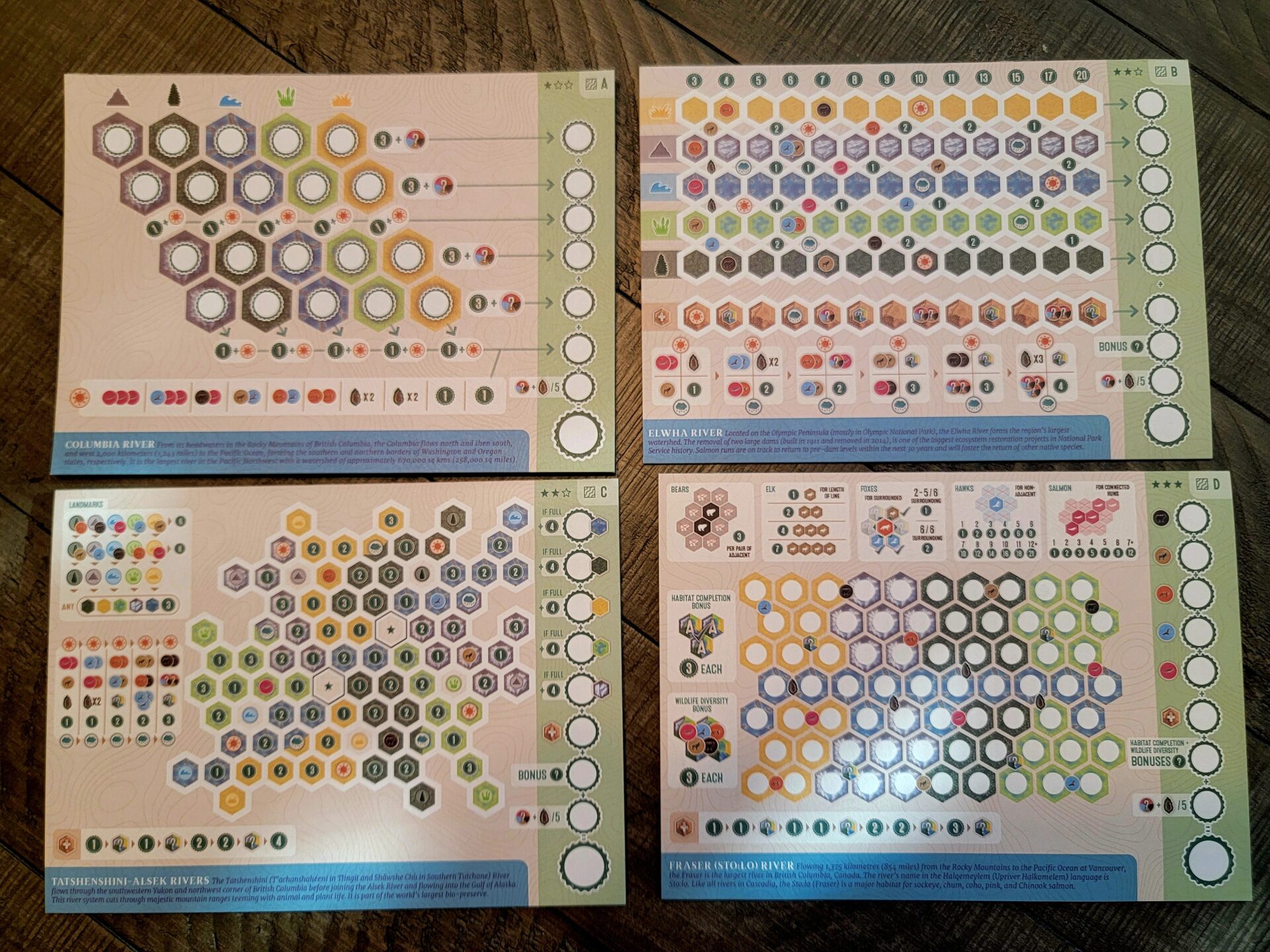
Map Details
As stated above , each of the four Cascadia Rolling maps plays a little differently. I won’t go into complete details, but I did want to give readers a sense of how these each differ in play.
Map A: billed as the least complex of the bunch, this map is a great starting place for new players. Each of the five habitat types is given it’s own column with a set of empty circles below them. When a card is purchased, the player will write the Point Value in the next empty circle under that card’s Habitat. Players gain extra points for filling both columns and rows, with the winner being the player with the most points summed from all circles at the end.
Map B: players will notice this sheet has a lot more happening on it when compared to Map A, but don’t let that intimidate you. This time, Habitats are laid out in rows with X hexagons printed to the right of each. When a player purchases a card, they will circle an amount of hexagons in the correct habitats row equal to the points printed on the cards. Players will be awarded bonuses as they mark more and more hexagons off as well as being awarded a higher value of points the further down the row they make.
Map C: gone are the columns and rows from Maps A & B, now the hexagons are laid out in a shape that, at least to me, looks like a rough sketch of the United States. The different Habitats are scattered around this shape and each is printed with a point value or a bonus. When a Habitat Card is purchased, players will mark an amount of hexagons equal to the points printed on the card which matched the Habitat on the card. Players have to circle hexagons that are adjacent to hexagons already marked but aren’t limited to having to mark all hexagons from a single round in the same area. Players can spread these markings around as long as they are touching a space that was marked preciously. Players will get points for circling Landmarks and for finishing off Habitat Types.
Map D: Lastly is the most complex map sheet. The complexity is increased because not only do players mark their sheet based on Habitat Type and Point Value from the purchased card, but they also must write a letter in each space to represent one of the Animal Types used to acquire the card. Scoring differs between Rivers and Hills so I’m not going to go into that here but I will say that fans of the original Cascadia will probably enjoy the familiarity they’ll find in Map D of Cascadia Rolling Rivers.
Solo Mode Thoughts
For those readers who have played other games created by Flatout Games, you will recognize the solo mode in Cascadia Rolling. It is primarily built around a variety of scenarios, where the rulebook lays out a combination of a map and bonus/discount cards and then challenges the player to reach a minimum number of cards. The scenarios also become more difficult as they add additional requirements besides just the minimum points. Sometimes this means that a player must fill up a certain amount of one Habitat or end the game with more than a certain amount of Nature Tokens.
There is also a set of achievements, players can work towards while just playing any form of Cascadia Rolling. When players either fulfill an achievement or complete a scenario, they can then fill in a bubble on the Cacadia map to track their progress. I am a huge fan of how Flatout Games handles this system and when I’m a solo player, it really adds to the drive to play this game versus one that’s only goal is to beat your high score.
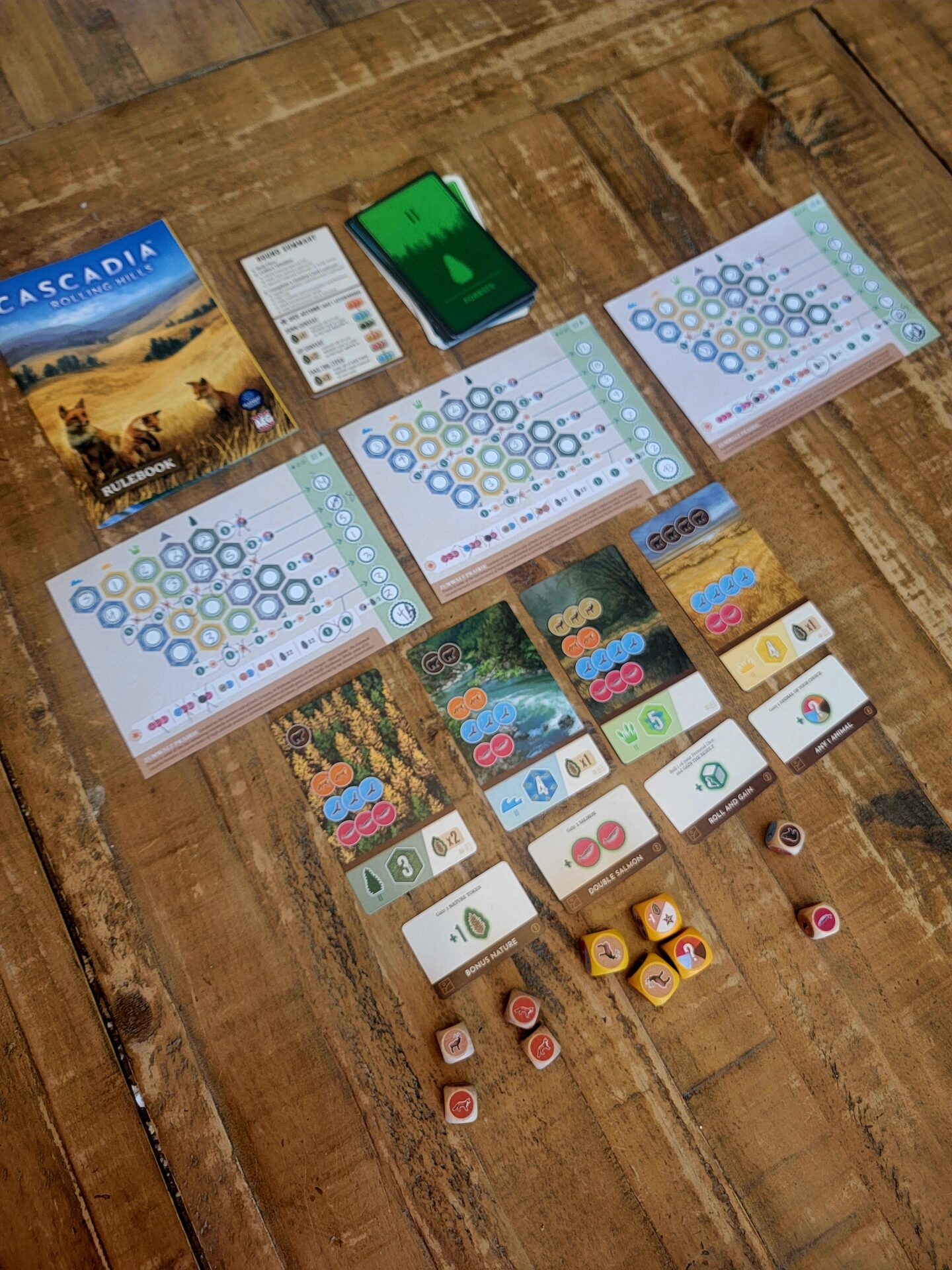
Conclusion
Even though Cascadia Rolling exists in the Cascadia world of games, I don’t necessarily think fans of one means they will be fans of the other, since both games’ share very few similarities. My wife falls into the camp of thinking Cascadia is boring and she very rarely likes abstract games. On the other hand, she has had a lot of fun with Cascadia Rolling, at least with Maps A and B, and has chosen it over other games more than a few times.
Gamers who are looking for a lighter, dice game that takes up a small space and travels well should definitely look into Cascadia Rolling. If you are never going to have more than four players, I recommend only getting Rivers or Hills but if you typically have larger groups, where more than four players will take part, make sure to grab both Cascadia Rolling products.
Rating
Ratings are based on 5 main criteria: rulebook, setup, components, art & graphic design, and gameplay. The first 4 criteria are rated 1 to 5 and the gameplay is rated 1 to 10. These scores culminate in an “overall satisfaction” score that is rated from 1 to 10. If the reviewed game has both a solo and multiplayer mode, I have assigned scores separately to give context to which mode we enjoy more.
Links
As an Amazon Associate I earn from qualifying purchases.
Amazon: Amazon.com: Cascadia Rolling Rivers Board Game – Kickstarter Deluxe Edition : Toys & Games

